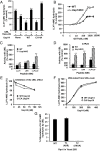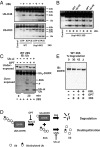UBL domain of Usp14 and other proteins stimulates proteasome activities and protein degradation in cells
- PMID: 30487212
- PMCID: PMC6294929
- DOI: 10.1073/pnas.1808731115
UBL domain of Usp14 and other proteins stimulates proteasome activities and protein degradation in cells
Erratum in
-
Correction for Kim and Goldberg, UBL domain of Usp14 and other proteins stimulates proteasome activities and protein degradation in cells.Proc Natl Acad Sci U S A. 2019 Jan 22;116(4):1459. doi: 10.1073/pnas.1822051116. Epub 2019 Jan 14. Proc Natl Acad Sci U S A. 2019. PMID: 30642963 Free PMC article. No abstract available.
Abstract
The best-known function of ubiquitin-like (UBL) domains in proteins is to enable their binding to 26S proteasomes. The proteasome-associated deubiquitinating enzyme Usp14/UBP6 contains an N-terminal UBL domain and is an important regulator of proteasomal activity. Usp14 by itself represses multiple proteasomal activities but, upon binding a ubiquitin chain, Usp14 stimulates these activities and promotes ubiquitin-conjugate degradation. Here, we demonstrate that Usp14's UBL domain alone mimics this activation of proteasomes by ubiquitin chains. Addition of this UBL domain to purified 26S proteasomes stimulated the same activities inhibited by Usp14: peptide entry and hydrolysis, protein-dependent ATP hydrolysis, deubiquitination by Rpn11, and the degradation of ubiquitinated and nonubiquitinated proteins. Thus, the binding of Usp14's UBL (apparently to Rpn1's T2 site) seems to mediate the activation of proteasomes by ubiquitinated substrates. However, the stimulation of these various activities was greater in proteasomes lacking Usp14 than in wild-type particles and thus is a general response that does not involve some displacement of Usp14. Furthermore, the UBL domains from hHR23 and hPLIC1/UBQLN1 also stimulated peptide hydrolysis, and the expression of hHR23A's UBL domain in HeLa cells stimulated overall protein degradation. Therefore, many UBL-containing proteins that bind to proteasomes may also enhance allosterically its proteolytic activity.
Keywords: UBL domain; Usp14/Ubp6; hHR23/Rad23; hPLIC/ubiquilin; proteasome activation.
Conflict of interest statement
The authors declare no conflict of interest.
Figures




Similar articles
-
The deubiquitinating enzyme Usp14 allosterically inhibits multiple proteasomal activities and ubiquitin-independent proteolysis.J Biol Chem. 2017 Jun 9;292(23):9830-9839. doi: 10.1074/jbc.M116.763128. Epub 2017 Apr 17. J Biol Chem. 2017. PMID: 28416611 Free PMC article.
-
Proteins containing ubiquitin-like (Ubl) domains not only bind to 26S proteasomes but also induce their activation.Proc Natl Acad Sci U S A. 2020 Mar 3;117(9):4664-4674. doi: 10.1073/pnas.1915534117. Epub 2020 Feb 18. Proc Natl Acad Sci U S A. 2020. PMID: 32071216 Free PMC article.
-
Ubiquitinated proteins promote the association of proteasomes with the deubiquitinating enzyme Usp14 and the ubiquitin ligase Ube3c.Proc Natl Acad Sci U S A. 2017 Apr 25;114(17):E3404-E3413. doi: 10.1073/pnas.1701734114. Epub 2017 Apr 10. Proc Natl Acad Sci U S A. 2017. PMID: 28396413 Free PMC article.
-
Mechanisms That Activate 26S Proteasomes and Enhance Protein Degradation.Biomolecules. 2021 May 22;11(6):779. doi: 10.3390/biom11060779. Biomolecules. 2021. PMID: 34067263 Free PMC article. Review.
-
Meddling with Fate: The Proteasomal Deubiquitinating Enzymes.J Mol Biol. 2017 Nov 10;429(22):3525-3545. doi: 10.1016/j.jmb.2017.09.015. Epub 2017 Oct 5. J Mol Biol. 2017. PMID: 28988953 Free PMC article. Review.
Cited by
-
Negative Modulation of Macroautophagy by Stabilized HERPUD1 is Counteracted by an Increased ER-Lysosomal Network With Impact in Drug-Induced Stress Cell Survival.Front Cell Dev Biol. 2022 Mar 2;10:743287. doi: 10.3389/fcell.2022.743287. eCollection 2022. Front Cell Dev Biol. 2022. PMID: 35309917 Free PMC article.
-
Regulation of Proteasome Activity by (Post-)transcriptional Mechanisms.Front Mol Biosci. 2019 Jul 16;6:48. doi: 10.3389/fmolb.2019.00048. eCollection 2019. Front Mol Biosci. 2019. PMID: 31380390 Free PMC article. Review.
-
USP14 promotes the malignant progression and ibrutinib resistance of mantle cell lymphoma by stabilizing XPO1.Int J Med Sci. 2023 Apr 1;20(5):616-626. doi: 10.7150/ijms.80467. eCollection 2023. Int J Med Sci. 2023. PMID: 37082728 Free PMC article.
-
AKT and DUBs: a bidirectional relationship.Cell Mol Biol Lett. 2025 Jul 7;30(1):77. doi: 10.1186/s11658-025-00753-3. Cell Mol Biol Lett. 2025. PMID: 40624457 Free PMC article. Review.
-
Identification of AKOS, a Chikungunya virus inhibitor, as a USP14 inhibitor for colorectal cancer treatment.Acta Pharmacol Sin. 2025 Jul 17. doi: 10.1038/s41401-025-01616-5. Online ahead of print. Acta Pharmacol Sin. 2025. PMID: 40676218
References
-
- Kisselev AF, et al. The caspase-like sites of proteasomes, their substrate specificity, new inhibitors and substrates, and allosteric interactions with the trypsin-like sites. J Biol Chem. 2003;278:35869–35877. - PubMed
Publication types
MeSH terms
Substances
Grants and funding
LinkOut - more resources
Full Text Sources
Miscellaneous

